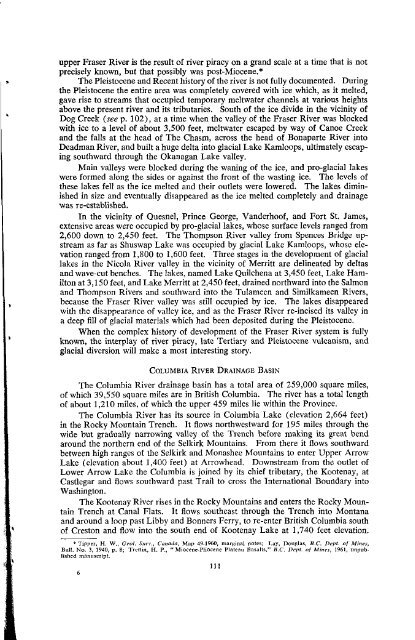Landforms of British Columbia 1976 - Department of Geography
Landforms of British Columbia 1976 - Department of Geography
Landforms of British Columbia 1976 - Department of Geography
Create successful ePaper yourself
Turn your PDF publications into a flip-book with our unique Google optimized e-Paper software.
upper Fraser River is the result <strong>of</strong> river piracy on a grand scale at a time that is not<br />
precisely known, but that possibly was post-Miocene.*<br />
The Pleistocene and Recent history <strong>of</strong> the river is not fully documented. During<br />
the Pleistocene the entire area was completely covered with ice which, as it melted,<br />
gave rise to streams that occupied temporary meltwater channels at various heights<br />
above the present river and its tributaries. South <strong>of</strong> the ice divide in the vicinity <strong>of</strong><br />
Dog Creek (seep. 102), at a time when the valley <strong>of</strong> the Fraser River was blocked<br />
with ice to a level <strong>of</strong> about 3,500 feet, meltwater escaped by way <strong>of</strong> Canoe Creek<br />
and the falls at the head <strong>of</strong> The Chasm, across the head <strong>of</strong> Bonaparte River into<br />
Deadman River, and built a huge delta into glacial Lake Kamloops, ultimately escap-<br />
ing southward through the Okanagan Lake valley.<br />
Main valleys were blocked during the waning <strong>of</strong> the ice, and pro-glacial lakes<br />
were formed along the sides or against the front <strong>of</strong> the wasting ice. The levels <strong>of</strong><br />
these lakes fell as the ice melted and their outlets were lowered. The lakes dimin-<br />
ished in size and eventually disappeared as the ice melted completely and drainage<br />
was re-established.<br />
In the vicinity <strong>of</strong> Quesnel, Prince George, Vanderho<strong>of</strong>, and Fort St. James,<br />
extensive areas were occupied by pro-glacial lakes, whose surface levels ranged from<br />
2,600 down to 2,450 feet. The Thompson River valley from Spences Bridge up-<br />
stream as far as Shuswap Lake was occupied by glacial Lake Kamloops, whose ele-<br />
vation ranged from 1,800 to 1,600 feet. Three stages in the development <strong>of</strong> glacial<br />
lakes in the Nicola River valley in the vicinity <strong>of</strong> Merritt are delineated by deltas<br />
and wave-cut benches. The lakes, named Lake Quilchena at 3,450 feet, Lake Ham-<br />
ilton at 3,150 feet, and Lake Merritt at 2,450 feet, drained northward into the Salmon<br />
and Thompson Rivers and southward into the Tulamecn and Similkameen Rivers,<br />
because the Fraser River valley was still occupied by ice. The lakes disappeared<br />
with the disappearance <strong>of</strong> valley ice, and as the Fraser River re-incised its valley in<br />
a deep fill <strong>of</strong> glacial materials which had been deposited during the Pleistocene.<br />
When the complex history <strong>of</strong> development <strong>of</strong> the Fraser River system is fully<br />
known, the interplay <strong>of</strong> river piracy, late Tertiary and Pleistocene vulcanism, and<br />
glacial diversion will make a most interesting story.<br />
COLUMBIA RIVER DRAINAGE BASIN<br />
The <strong>Columbia</strong> River drainage basin has a total area <strong>of</strong> 259,000 square miles,<br />
<strong>of</strong> which 39,550 square miles arc in <strong>British</strong> <strong>Columbia</strong>. The river has a total length<br />
<strong>of</strong> about 1,210 miles, <strong>of</strong> which the upper 459 miles lie within the Province.<br />
The <strong>Columbia</strong> River has its source in <strong>Columbia</strong> Lake (elevation 2,664 feet)<br />
in the Rocky Mountain Trench. It flows northwestward for 195 miles through the<br />
wide but gradually narrowing valley <strong>of</strong> the Trench before making its great bend<br />
around the northern end <strong>of</strong> the Selkirk Mountains. From there it flows southward<br />
between high ranges <strong>of</strong> the Selkirk and Monashee Mountains to enter Upper Arrow<br />
Lake (elevation about 1,400 feet) at Arrowhead. Downstream from the outlet <strong>of</strong><br />
Lower Arrow Lake the <strong>Columbia</strong> is joined by its chief tributary, the Kootenay, at<br />
Castlegar and flows southward past Trail to cross the International Boundary into<br />
Washington.<br />
The Kootenay River rises in the Rocky Mountains and enters the Rocky Moun-<br />
tain Trench at Canal Flats. It flows southeast through the Trench into Montana<br />
and around a loop past Libby and Banners Ferry, to reenter <strong>British</strong> <strong>Columbia</strong> south<br />
<strong>of</strong> Creston and flow into the south end <strong>of</strong> Kootenay Lake at 1,740 feet elevation.











